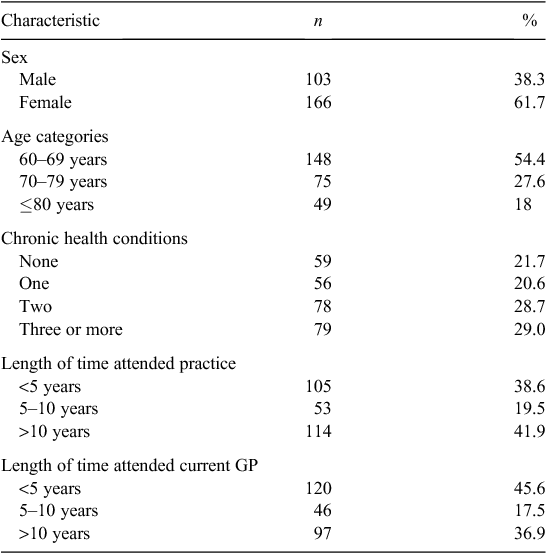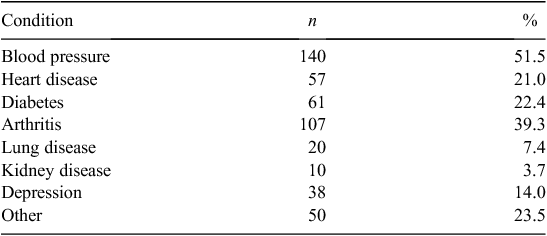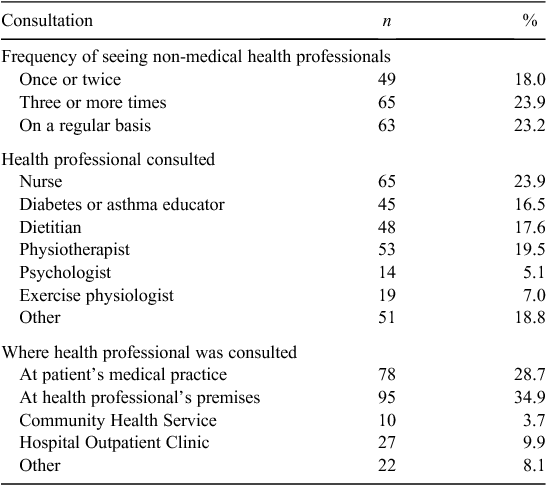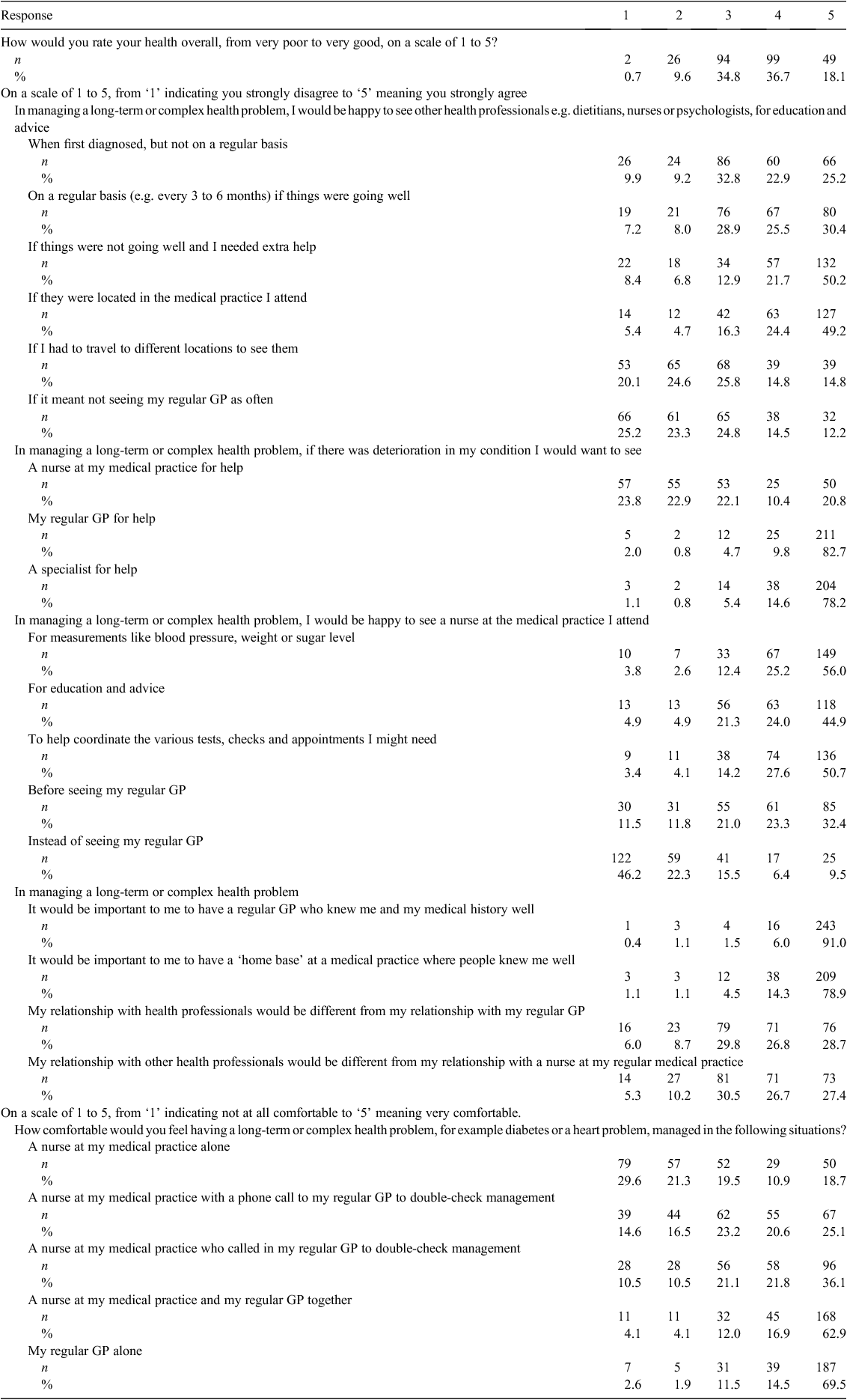Cross-sectional survey of older patients’ views regarding multidisciplinary care for chronic conditions in general practice
Andrew Bonney A B D , Christopher Magee B and Russell Pearson CA Graduate School of Medicine, Building 28, University of Wollongong, Northfields Avenue, Wollongong, NSW 2522, Australia.
B Centre for Health Initiatives, Building 233 (ITAMS), Innovation Campus, University of Wollongong, Northfields Avenue, Wollongong, NSW 2522, Australia.
C Shell Cove Family Health, Shallows Drive, Shell Cove, NSW 2529, Australia.
D Corresponding author. Email: abonney@uow.edu.au
Australian Journal of Primary Health 20(1) 27-33 https://doi.org/10.1071/PY12101
Submitted: 16 August 2012 Accepted: 24 October 2012 Published: 19 November 2012
Abstract
The ageing population and increasing prevalence of chronic illness have contributed to the need for significant primary care reform, including increased use of multidisciplinary care and task substitution. This cross-sectional study explores conditions under which older patients would accept having health professionals other than their general practitioner (GP) involved in their care for chronic disease management (CDM). Ten practices were randomly sampled from a contiguous major city and inner regional area. Questionnaires were distributed to consecutive patients aged 60 years and over in each practice. Agency theory was used to inform analyses. Statistical analysis was undertaken using Wald’s test, growth modelling and linear regression, controlling for the clustered design. The response rate was 53% (n = 272). Most respondents (79%) had at least one chronic health condition. Respondents were more comfortable with GP than with practice nurse management in the CDM scenario (Wald’s test = 105.49, P < 0.001). Comfort with practice nurse CDM was positively associated with increased contact with their GP at the time of the visit (β = 0.41, P < 0.001), negatively associated with the number of the respondent’s chronic conditions (β = –0.13, P = 0.030) and not associated with the frequency of other health professional visits. Agency theory suggests that patients employ continuity of care to optimise factors important in CDM: information symmetry and goal alignment. Our findings are consistent with the theory and lend support to ensuring that interpersonal continuity of care is not lost in health care reform. Further research exploring patients’ acceptance of differing systems of care is required.
Additional keywords: agency theory, practice nurse, team care.
| What is known about the topic? |
• Despite high satisfaction with nurse-led primary health care, the specific nature of the care delivered has been shown to influence patient preference for health care provider. |
| What does this paper add? |
• This study suggests that older patients are accepting of many aspects of primary care reform, but are more comfortable with nurse-led care when they feel their general practitioner remains involved in that care. |
Introduction
The ageing population and associated increase in the burden of chronic illness are well recognised (AIHW 2008). This demographic shift is reflected in the caseloads in Australian general practice where currently over 40% of all consultations address chronic problems (Britt et al. 2009). In addition, older patients have significantly increased utilisation of general practice services (Harrison and Britt 2011). Hence, it is estimated that by 2020 the ageing population may increase the required number of general practitioners (GPs) by up to 45% above that required by population increase alone (Harrison and Britt 2011). Understandably, there is significant health policy interest in structural reform to enable our health system to best meet the needs of this ageing population and the increasing prevalence of chronic disease (NHHRC 2009). In primary care, in addition to expanding the medical workforce (Harrison and Britt 2011), enhancing the roles of nurses and other health professionals (HPs) in patient management is a logical development (Douglas et al. 2009). However, it would be desirable for any solution to incorporate mechanisms for increased productivity (Scott 2009). Therefore, it is important to investigate models of task substitution or delegation within primary care teams (Laurant et al. 2005).
With some recent exceptions, there has been relatively little Australian research into patients’ attitudes towards enhanced non-medical HP roles in primary care (Eley et al. 2012). As older patients and patients with chronic conditions particularly value interpersonal continuity with a single medical practitioner (Nutting et al. 2003), research into how to reconcile these preferences with the changing health care environment is vital. Such reconciliation may be possible if the functions of interpersonal continuity valued by patients are identified and maintained in evolving systems of health care delivery.
Agency theory has been proposed as a framework for reconceptualising interpersonal continuity of care (Donaldson 2001). Agency theory deals with the so-called ‘agency problem’, which exists when one person (a principal) engages another (an agent) to act on their behalf (Eisenhardt 1989), such as in a patient−HP relationship. In agency relationships it is held that risks arise when principals and agents have incomplete information concerning each other or have divergent goals (Shapiro 2005). Interpersonal continuity of care in health care agency relationships can be seen as a means by which patients (principals) can optimise shared knowledge and develop shared goals with their HPs (agents) (Donaldson 2001). Thus, agency theory may have value as a framework for research into complex care systems, such as multidisciplinary teams, and the evaluation of the degree to which the functions of interpersonal continuity valued by patients are expressed (Donaldson 2001).
This cross-sectional study explores older patients’ attitudes to the involvement of HPs other than their GP in their chronic disease management (CDM). The findings are discussed in the context of agency theory and its utility as a theoretical framework for the design and evaluation of evolving processes of CDM.
Methods
Ethics approval for the study was obtained through the Human Research Ethics Committee of the University of Wollongong.
Materials
The authors used an existing instrument, previously used in a large Australian survey, as a template (Bonney et al. 2012). This instrument had been designed for self-administration and measured the attitudes of older patients to GP trainees. The instrument’s psychometric properties had been examined and the instrument was demonstrated to explore the constructs of interpersonal continuity of care, interpersonal trust and system and institution trust (Bonney et al. 2011). The authors adapted the instrument’s items to explore the attitudes of older patients to other HPs within these constructs in an iterative process, including developing new questions and substituting different care providers in questions (e.g. ‘a nurse at my medical practice’ substituted for ‘a new doctor’). The adapted instrument was piloted by 39 patients in one practice undertaking the survey. The authors analysed the pattern of responses and as a result removed four items with low completion rates and reformatted the instrument to create more ‘white space’ to improve readability. The final instrument contained: nine categorical items regarding demographics; the presence, type and number of chronic conditions; and GP, nursing and allied health provider utilisation. It included a self-rated health item and 23 items regarding attitudes to CDM by doctors and other HPs. Participants were asked to indicate how comfortable they would feel having a chronic or complex health problem managed in the five following scenarios, adapted for this study: (1) by a nurse at the medical practice (nurse alone); (2) by a nurse at the medical practice with a phone call to the GP to double-check management (nurse + phone call); (3) a nurse at the medical practice who called in the regular GP to double-check management (nurse + double check); (4) a nurse and the GP together (nurse + GP); and (5) the regular GP alone (GP alone). Each of the attitudinal items in the instrument used a hybrid visual analogue/5-point Likert response format for assessment.
Recruitment
In June 2011, a randomised stratified sample of 10 general practices within the planned boundaries of a Medicare Local were recruited, such that there was proportional sampling of Australian Standard Geographical Classification – Remoteness Area (RA)1 (Major City) and RA2 (Inner Regional) designated practices. Personnel in each practice received training and were instructed to distribute questionnaires to forty consecutive patients aged 60 years and over for self-completion without assistance in the waiting room. Questionnaires left blank by respondents were redistributed in a second wave in each practice using the same procedure. The total number of patients to whom instruments were distributed in each practice was recorded.
Analyses
All analyses were performed using Mplus version 6.11 (Muthén and Muthén 1998–2010) and adjusted for the effects of the clustered data (i.e. practices). Growth modelling investigated patient comfort in the CDM scenario in which there were incremental increases in interpersonal continuity with the patient’s regular GP. Growth modelling (also referred to as latent growth curve modelling) is a statistical approach based on a structural equation modelling framework that analyses within-subject data. Linear regression examined patient comfort with nurse CDM when the patient’s usual GP was called in to ‘double-check’ management. This scenario was chosen as being a practicable implementation of CDM with an ‘alternative agent’ within Australian general practice. The patient’s level of comfort with this scenario was selected as the dependent variable, with the patient’s age, sex, number of chronic illnesses (a proxy for complexity), length of time seeing their usual GP and frequency of visits to other HPs as the independent variables. Internal reliability for the 23 attitude items was assessed using Cronbach’s α. Statistical significance was set at P < 0.05.
Results
Descriptive statistics
Seven RA1 practices (from 11 invited) and three RA2 practices (from six invited) agreed to participate. Instruments were distributed to an estimated 511 patients. Of the 354 surveys attempted, 272 were satisfactorily completed (i.e. age identified and at least 50% of attitude items completed) and included in the analyses, giving an effective response rate of 53.2%. The final sample thus included 272 respondents aged 60–98 years (median 69.0, M = 70.6, s.d. = 8.0) of whom 61.7% (n = 166) were female. The majority of the respondents self-reported that they had a ‘long-term or complex health problem’ (79.3%). Further description of the sample is outlined in Table 1.

|
The most commonly reported chronic health problems were blood pressure (51.5%), arthritis (39.3%), diabetes (22.4%) and heart disease (21.0%). Two-thirds (65.1%) of respondents had seen a non-medical HP for assistance in the management of a chronic health problem. Furthermore, 23.9% of respondents had consulted a nurse and 19.5% a physiotherapist for a chronic health problem. Table 2 displays the prevalence of patients’ self-reported chronic health problems, and Table 3 the types of HPs seen, frequencies and locations.

|

|
Attitudes to multidisciplinary team members
Nearly three-quarters of respondents were happy to see a non-medical HP for assistance ‘if things were not going well and I needed extra help’ (agree 21.7%; strongly agree 50.2%). Most respondents were happy to see a practice nurse (PN) at their medical practice for clinical tasks including measurements such as blood pressure and sugar level (agree 25.2%; strongly agree 56.0%), education and advice (agree 24.0%; strongly agree 44.9%) and care co-ordination (agree 27.6%; strongly agree 50.7%). Nearly all respondents wanted to see their GP if their condition deteriorated (agree 9.8%; strongly agree 82.7%). Table 4 presents all of the responses to the attitude items.

|
Growth modelling and linear regression results
For the management of a long-term or complex health problem, participants’ mean comfort scores were significantly higher with their GP (M = 4.46, s.d. = 0.95) compared with a nurse alone (M = 2.68, s.d. = 1.47, Wald’s test = 105.49, P < 0.001). The growth model indicated that patient comfort increased linearly across the five different scenarios (β = 0.41, P < 0.001). The means and standard deviations for each of the five scenarios are presented in Table 5.

|
Patient comfort with the ‘nurse CDM + GP called in to double-check’ scenario decreased as the number of chronic health conditions increased (β = –0.13, P = 0.030). Patient comfort was lower for those who had seen their GP for 1–4 years (β = –0.63, P = 0.002) compared with <1 year. Age was significantly associated with patient comfort. In particular, compared with patients aged less than 70 years, patients who were age 80 years and over had higher levels of comfort with this scenario (β = 0.55, P = 0.001); there was no significant difference in patient comfort between those aged 70–79 years and those less than 70 years. Patient sex and frequency of visits to other HPs were not associated with patient comfort.
Internal reliability
Cronbach’s α for the 23 attitude items was 0.80.
Discussion
Overview of findings
Respondents reported significantly higher comfort with their GP compared with their PN as a single agent for CDM in this study. There was a significant positive relationship between the degree of comfort with PN-CDM and the extent of personal contact with their GP associated with that care, and there was a significant negative association between comfort with PN-CDM and increasing care complexity. Increased exposure to other HPs was not associated with attitudes to the PN-CDM scenario in our analyses. The results suggested that participants viewed the input of both PNs and other HPs as valued supplements to their CDM, but not a substitute for their GP. The findings also suggested that the participants viewed their relationships with GPs, PNs and other HPs to be different from each other.
Comparison with the literature
The value older patients and those with chronic illness place on interpersonal continuity of care with a GP has been well documented, including the increased value placed on interpersonal continuity with an increasing number of chronic conditions (Nutting et al. 2003). It is also well documented that patients report high satisfaction with nurse-led primary health care (Laurant et al. 2005, 2008; Eley et al. 2012), including a systematic review concluding there is higher satisfaction with nursing care compared with medical care (Laurant et al. 2005). However, the specific nature of the care delivered has also previously been shown to influence patient preference (rather than satisfaction). For example, one study demonstrated that most patients express a preference for their GP for medical aspects of care, whereas preference for GP and nurse practitioner care is comparable for educational and routine aspects of care (Laurant et al. 2008).
The present study adds to these findings in the literature in several respects. It provides preliminary quantitative data concerning patients’ attitudes to enhanced non-medical roles in CDM in primary care in Australia. In addition, the study has supplied data indicating conditions under which older patients’ preferences for CDM may be met whilst providing improved efficiencies of care. Of interest, these findings were consistent with agency theory, a theoretical framework that has been extensively used in the economics (Shapiro 2005), health economics (Sekwat 2000; Schneider and Mathios 2006) and social sciences literature (Eisenhardt 1989). In an agency framework, it is anticipated that a patient would feel less risk where there is the involvement of a HP with whom they have a long-term relationship across all aspects of care as this optimises information symmetry and goal alignment in the care encounter (Donaldson 2001). The risk of information asymmetry increases with the increasing complexity of that information and, hence, it would be anticipated that patients would have a higher requirement for continuity with increasing multimorbidity.
Implications for practice
The findings indicate that older patients support important features of health care reform in general practice, including co-location of HPs in general practices, multidisciplinary CDM teams and advanced roles for PNs (NHHRC 2009). At the same time, the results again demonstrate the importance to older patients of interpersonal continuity of care with their GP (Nutting et al. 2003). As interpersonal continuity is also associated with better outcomes for older patients (Ionescu-Ittu et al. 2007; Worrall and Knight 2011), the findings of this study lend support to ensuring that this continuity is not lost in the midst of health care reform (Bonney and Farmer 2010). The medical aspects of CDM, such as prescribing, investigation and referral, are outside of the scope of PNs at the moment. Older patients’ comfort with PN-CDM appears significantly improved with a model of ‘shared continuity’ with their GP. Thus, this model also provides a mechanism for the medical aspects of CDM to be undertaken efficiently in conjunction with those aspects of PN-CDM that receive high patient acceptance and satisfaction (Eley et al. 2012). There is also indication that a ‘shared continuity’ model may not suit every patient, with increasing complexity of care being associated with reduced patient comfort with this scenario. Thus, for patients with complex care needs, more intensive interaction with their GP may both be clinically desirable and have greater acceptance by patients.
Limitations and future research
The findings of this study should be interpreted in light of its limitations. The modest sample size, effective response rate of 53% and inability to track non-responders may all potentially reduce the generalisability of the results. Responder bias should also be considered, as patients with poor health literacy may have had more difficulty completing the questionnaires. Reception staff in general practice are extremely busy and this understandably affected questionnaire distribution. It is not possible to verify that distribution was to consecutive patients. It was also acknowledged that the records of the number of patients to whom questionnaires were distributed in three practices may not have been accurate. The authors sought to overestimate distribution in order not to falsely inflate the response rate. It is also acknowledged that the wording ‘GP to double-check on management’ does not accurately reflect the professional interaction between the PN and GP. As with any cross-sectional research, the study can only demonstrate associations. Therefore, further investigation of these relationships would be desirable, and should include evaluation of models of ‘shared continuity’ in CDM.
Conclusion
Continuity of care matters (Guthrie et al. 2008), particularly for older patients and those with chronic conditions (Nutting et al. 2003), as demonstrated in this study. However, the rapidly changing demographics of our population mandate evolution in the way in which primary care is structured. The findings of this study lend support to further investigation of models of ‘shared continuity’ for CDM, support the utility of agency theory as a framework in this context and provide encouragement that it is feasible to undertake health care reform and preserve interpersonal continuity as a central tenet of primary care (Bonney and Farmer 2010).
Conflicts of interest
None declared.
Acknowledgements
This study was supported by funding from the University of Wollongong. The authors thank Ms Brigid Condon for research assistance, Mr Darren Mayne for statistical advice and the practices involved.
References
AIHW (2008) ‘Incidence and prevalence of chronic diseases.’ (Australian Government: Canberra) Available at http://www.aihw.gov.au/cdarf/data_pages/incidence_prevalence/index.cfm [Verified 26 May 2010]Bonney A, Farmer E (2010) Health care reform: can we maintain personal continuity? Australian Family Physician 39, 455–456.
Bonney A, Magee C, Caputi P (2011) Measuring older patients’ attitudes to general practice registrars: exploratory factor analysis of a survey instrument. Focus on Health Professional Education: A Multi-Disciplinary Journal 12, 74–85.
Bonney A, Jones SC, Iverson D (2012) The older patient, the general practitioner and the trainee: patients’ attitudes and implications for training. Education for Primary Care 23, 186–195.
Britt H, Miller GC, Charles J, Henderson J, Bayram C, Pan Y, Valenti L, Harrison C, Fahridin S, O’Halloran J (2009) ‘General practice activity in Australia, 2008–09.’ General practice series no. 25. Cat. no. GEP 25. (AIHW: Canberra)
Donaldson MS (2001) Continuity of care: a reconceptualization. Medical Care Research and Review 58, 255–290.
| Continuity of care: a reconceptualization.Crossref | GoogleScholarGoogle Scholar | 1:STN:280:DC%2BD3MvotVSrsQ%3D%3D&md5=6ac925d897bdbcf4cda02afeeb0a8518CAS |
Douglas KA, Rayner FK, Yen LE, Wells RW, Glasgow NJ, Humphreys JS (2009) Australia’s primary health care workforce – research informing policy. The Medical Journal of Australia 191, 81–84.
Eisenhardt KM (1989) Agency theory: an assessment and review. Academy of Management Review 14, 57–74.
Eley DS, Patterson E, Young J, Fahey PP, Del Mar CB, Hegney DG, Synnott RL, Mahomed R, Baker PG, Scuffham PA (2012) Outcomes and opportunities: a nurse-led model of chronic disease management in Australian general practice. Australian Journal of Primary Health
| Outcomes and opportunities: a nurse-led model of chronic disease management in Australian general practice.Crossref | GoogleScholarGoogle Scholar |
Guthrie B, Saultz JW, Freeman GK, Haggery JL (2008) Continuity of care matters. British Medical Journal 337, a867
| Continuity of care matters.Crossref | GoogleScholarGoogle Scholar |
Harrison C, Britt H (2011) General practice − workforce gaps now and in 2020. Australian Family Physician 40, 12–15.
Ionescu-Ittu R, McCusker J, Ciampi A, Vadeboncoeur AM, Roberge D, Larouche D, Verdon J, Pineault R (2007) Continuity of primary care and emergency department utilization among elderly people. Canadian Medical Association Journal 177, 1362–1368.
| Continuity of primary care and emergency department utilization among elderly people.Crossref | GoogleScholarGoogle Scholar |
Laurant M, Reeves D, Hermens R, Braspenning J, Grol R, Sibbald B (2005) Substitution of doctors by nurses in primary care. Cochrane Database of Systematic Reviews 2, CD001271
Laurant MGH, Hermens RPMG, Braspenning JCC, Akkermans RP, Sibbald B, Grol RPTM (2008) An overview of patients’ preference for, and satisfaction with, care provided by general practitioners and nurse practitioners. Journal of Clinical Nursing 17, 2690–2698.
| An overview of patients’ preference for, and satisfaction with, care provided by general practitioners and nurse practitioners.Crossref | GoogleScholarGoogle Scholar |
Muthén LK, Muthén BO (1998–2010) ‘Mplus user’s guide.’ 6th edn. (Muthén & Muthén: Los Angeles, CA)
NHHRC (2009) A healthier future for all Australians − final report of the National Health and Hospitals Reform Commission, June 2009. Commonwealth of Australia, Canberra. Available at http://www.health.gov.au/internet/nhhrc/publishing.nsf/Content/nhhrc-report [Verified 28 September 2010]
Nutting PA, Goodwin MA, Flocke SA, Zyzanski SJ, Stange KC (2003) Continuity of primary care: to whom does it matter and when? Annals of Family Medicine 1, 149–155.
| Continuity of primary care: to whom does it matter and when?Crossref | GoogleScholarGoogle Scholar |
Schneider H, Mathios A (2006) Principal agency theory and health care utilization. Economic Inquiry 44, 429–441.
| Principal agency theory and health care utilization.Crossref | GoogleScholarGoogle Scholar |
Scott IA (2009) Health care workforce crisis in Australia: too few or too disabled? The Medical Journal of Australia 190, 689–692.
Sekwat A (2000) Principal-agent theory: a framework for improving health care reform in Tennessee. Journal of Health and Human Services Administration 22, 277–291.
Shapiro SP (2005) Agency theory. Annual Review of Sociology 31, 263–284.
| Agency theory.Crossref | GoogleScholarGoogle Scholar |
Worrall G, Knight J (2011) Continuity of care is good for elderly people with diabetes: retrospective cohort study of mortality and hospitalization. Canadian Family Physician Medecin de Famille Canadien 57, e16–e20.


